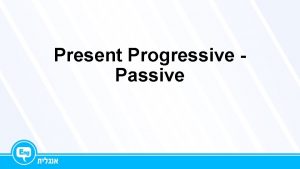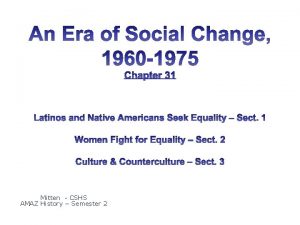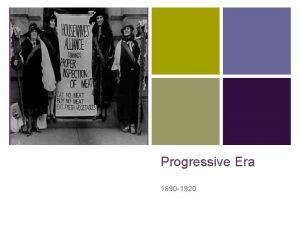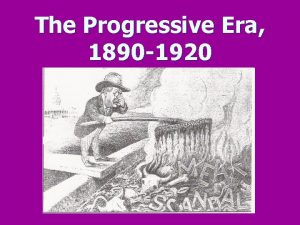The Progressive Era 1890 1920 Mitten CSHS AMAZ

















- Slides: 17

The Progressive Era 1890 - 1920 Mitten – CSHS AMAZ History Semester 2

The Origins of Progressivism • The Origins of Progressivism – Political, economic, and social change in the late 19 th century America leads to progressive reforms.

The Progressive Era • Progressive Era – 1890 – 1920 – Period of great political and social change • Women gain a larger public role – women lead the call for reform • President Theodore Roosevelt institutes reform policies and calls them the Square Deal

Four Goals of Progressivism • Concerns of Progressives • Early 1900’s, middle class reformers address problems of 1890’s – different reform efforts collectively called progressive movement • Reformers aim to restore economic opportunity, correct injustice by: – protecting social welfare, promoting moral improvement – creating economic reform, fostering efficiency

Four Goals of Progressivism • Protecting Social Welfare • Social Gospel, settlement houses inspire other reform groups • Florence Kelley, political activist, advocate for women, children – helps pass law prohibiting child labor, limiting women’s hours

Four Goals of Progressivism • Promoting Moral Improvement – Some feel poor should uplift themselves by improving own behavior – Prohibition – banning of alcoholic drinks – Woman’s Christian Temperance Union spearheads prohibition crusade

Four Goals of Progressivism • Creating Economic Reform • 1893 panic prompts doubts about capitalism; many become socialists – Muckrakers – journalists who expose corruption in politics, business • Fostering Efficiency • Many use experts, science to make society, workplace more efficient – Scientific management – time and motion studies applied to workplace • Assembly lines speed up production, make people work like machines

Cleaning Up Local Government • Reforming Local Government • Reformers focus on government efficiency – responsiveness to voters – Many use council-manager; people elect council that appoints manager • Reform Mayors - examples – Hazen Pingree of Detroit tackles taxes, transit fares, corruption – Socialist Tom Johnson of Cleveland fights corrupt utility companies

Reform at the State Level • Protecting Working Children • Child workers get lower wages, small hands handle small parts better • National Child Labor Committee gathers evidence of harsh conditions – groups pressure government to ban child labor, cut hours

Reform at State Level • Efforts to Limit Working Hours • Muller v. Oregon – court upholds limiting women to 10 hour day • Bunting v. Oregon – upholds 10 our workday for men – Reformers win workers’ compensation for families of injured, killed

Reforms at State Level • Reforming Elections • Oregon adopts secret ballot, initiative, referendum, recall – Initiative – bill proposed by people, not lawmakers, put on ballot – Referendum – voters, not legislature, decide if initiative becomes law – Recall – voters remove elected officials through early election • Primaries allow voters, not party machines, to choose candidates

Reform at the State Level • Direct Election of Senators • Seventeenth Amendment (17 th) – permits popular election of senators

Women in Public Life – Sect. 2 • Changing Patterns of Living • Only middle, upper class women can devote selves to home, family

Women in the Work Force • Domestic Workers • In 1870, 70% of employed women do domestic work • Women in Industry • After 1900, 1 in 4 women hold jobs; 25% in manufacturing

Women Lead Reform • Women Get Involved • Many female industrial workers seek to reform working conditions • Women in Higher Education – 50% college-educated women never marry; many work on social reforms

Women and Reform – National Association of Colored Women (NACW) – child care, education – Susan B. Anthony - National American Woman Suffrage Association (NAWSA)

Women Lead Reform • A Three Part Strategy for Suffrage – convince state legislatures – test 14 th Amendment – push for constitutional amendment
 Amaz scandal
Amaz scandal Hvem var medusa
Hvem var medusa Fiberoptik fysik
Fiberoptik fysik Mitten corner definition
Mitten corner definition Squish mitten
Squish mitten The mitten sequence of events
The mitten sequence of events Dog restraint techniques
Dog restraint techniques Mitten technique sterile
Mitten technique sterile Mitten in der dunkelheit hat sich gott gezeigt
Mitten in der dunkelheit hat sich gott gezeigt Glinty talons
Glinty talons Elbow and knee restraints
Elbow and knee restraints Past perfect continuous function
Past perfect continuous function Present progressive passive examples
Present progressive passive examples Past perfect v past simple
Past perfect v past simple Timeline tungkol sa el filibusterismo
Timeline tungkol sa el filibusterismo 1890'lı yıllarda ingiltere'de whiff
1890'lı yıllarda ingiltere'de whiff Alfred marshall principles of economics 1890
Alfred marshall principles of economics 1890 1890 computer
1890 computer
































